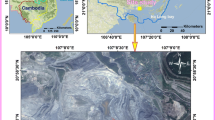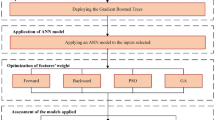Abstract
The establishment of accurate artificial intelligence (AI) prediction models for blast-induced noise is a hot topic in mining sciences due to its environmental and safety implications. However, when building these AI-based models, identifying the most critical input features from the widely used blast design and explosive parameters is a research gap yet to be fully explored. Therefore, this study was conducted to predict blast-induced noise by proposing a new synergistic model of neighbourhood component analysis (NCA) and AI method. First, the NCA reduced the original input data dimension by selecting the most relevant features. The resulting NCA selected features then served as inputs data for the various AI methods, including support vector machine (SVM), backpropagation neural network (BPNN), generalised regression neural network (GRNN) and radial basis function neural network (RBFNN). This created the respective hybrid models that merged NCA with AI to form NCA-SVM, NCA-BPNN, NCA-GRNN and NCA-RBFNN. The NCA-AI hybrid models were compared against the traditional single AI models (SVM, BPNN, GRNN and RBFNN) and hybrid models of principal component analysis (PCA) and AI (PCA-SVM, PCA-BPNN, PCA-GRNN and PCA-RBFNN). The models were statistically evaluated using root mean square error (RMSE), scatter index (SI), correlation coefficient (R), coefficient of residual mass (CRM), uncertainty at 95% (U95) and Bayesian Information Criterion (BIC). The overall analyses revealed more compelling predictions by merging NCA and AI. However, inter-comparison of the models shows that the NCA-BPNN is the best because it achieved the most extensive R (0.912) and the least RMSE (1.558 dB), SI (0.039), CRM (0.00), U95 (4.334) and BIC (78.4912) values. These study findings highlight NCA's significant role in improving AI-based blast-induced noise model prediction accuracy.












Similar content being viewed by others
Data availability
The datasets generated during and/or analysed during the current study are available from the corresponding author on reasonable request.
References
Amankwaa-Kyeremeh B, Greet C, Zanin M, Skinner W, Asamoah RK (2020) Selecting key predictor parameters for regression analysis using modified Neighbourhood Component Analysis (NCA) Algorithm. Proceedings of 6th UMaT Biennial International Mining and Mineral Conference, Tarkwa, Ghana, 320–325
Armaghani DJ, Mohamad ET, Hajihassani M, Abad S, Marto A, Moghaddam MR (2016) Evaluation and prediction of flyrock resulting from blasting operations using empirical and computational methods. Eng Comput 32:109–121
Arthur CK, Temeng VA, Ziggah YY (2020a) A Self-adaptive differential evolutionary extreme learning machine (SaDE-ELM): a novel approach to blast-induced ground vibration prediction. SN Appl Sci 2:1–23
Arthur CK, Temeng VA, Ziggah YY (2020b) Multivariate adaptive regression splines (MARS) approach to blast-induced ground vibration prediction. Int J Min Reclam Environ 34:198–222
Asante-Okyere S, Shen C, Ziggah YY, Rulegeya MM, Zhu X (2020) Principal component analysis (PCA) based hybrid models for the accurate estimation of reservoir water saturation. Comput Geosci 145:1–11
Baffoe PE, Duker AA, Senkyire-Kwarteng EV (2022) Assessment of health impacts of noise pollution in the Tarkwa Mining Community of Ghana using noise map** techniques. Glob Health J 6:19–29
Bansah KJ, Assan E, Bosompem C (2015) Predicting the levels of noise from quarry operations. In: 24th International Mining Congress and Exhibition of Turkey-IMCET’15 Antalya, Turkey, April 14–17, 1492–1496
Bengio Y, Grandvalet Y (2004) No unbiased estimator of the variance of K-fold cross-validation. J Mach Learn Res 5:1089–1105
Broomhead DS, Lowe D (1988) Multivariate functional interpolation and adaptive networks. Complex Syst 2:321–355
Bui XN, Jaroonpattanapong P, Nguyen H, Tran QH, Long NQ (2019) A novel hybrid model for predicting blast-induced ground vibration based on k-nearest neighbors and particle swarm optimization. Sci Rep 9:1–14
Burnham PK, Anderson RD (2002) Model selection and multimodel inference: a practical information-theoretic approach. Springer, New York
Daanouni O, Cherradi B, Tmiri A (2020) Diabetes Diseases Prediction Using Supervised Machine Learning and Neighbourhood Components Analysis. In Proceedings of the 3rd International Conference on Networking, Information Systems and Security, March 31–April 2, 2020, Marrakech, Morocco, 1–5
Despotovic M, Nedic V, Despotovic D, Cvetanovic S (2016) Evaluation of empirical models for predicting monthly mean horizontal diffuse solar radiation. Renew Sust Energ Rev 56:246–260
Drucker H, Burges CJC, Kaufman I, Smola A, Vapnik V (1997) Support vector regression machines. Adv Neural Inf Process Syst 9:155–161
Elemile OO, Ibitogbe EM, Folorunso OP, Ejiboye PO, Adewumi JR (2021) Principal component analysis of groundwater sources pollution in Omu-Aran Community, Nigeria. Environ Earth Sci 80:1–16
Fattahi H, Hasanipanah M (2021) Prediction of blast-induced ground vibration in a mine using relevance vector regression optimized by metaheuristic algorithms. Nat Resour Res 30:1849–1863
García-Cuesta E, Aler R, Pózo-Vázquez DD, Galván IM (2022) A combination of supervised dimensionality reduction and learning methods to forecast solar radiation. Appl Intell. https://doi.org/10.1007/s10489-022-04175-y
Goldberger J, Hinton GE, Roweis S, Salakhutdinov RR (2004) Neighbourhood components analysis. Adv Neural Inf Process Syst 17:1–8
He Z, Armaghani DJ, Masoumnezhad M, Khandelwal M, Zhou J, Murlidhar BR (2021) A combination of expert-based system and advanced decision-tree algorithms to predict air-overpressure resulting from quarry blasting. Nat Resour Res 30:1889–1903
Jain T, Singh SN, Srivastava SC (2011) Fast static available transfer capability determination using radial basis function neural network. Appl Soft Comput 11:2756–2764
Ju Q, Hu Y (2021) Source identification of mine water inrush based on principal component analysis and grey situation decision. Environ Earth Sci 80:1–14
Kapadia D, Jariwala N (2022) Prediction of tropospheric ozone using artificial neural network (ANN) and feature selection techniques. Model Earth Syst Environ 8:2183–2192
Karimi AM, Sadeghnejad S, Rezghi M (2021) Well-to-well correlation and identifying lithological boundaries by principal component analysis of well-logs. Comput Geosci 157:104942
Kumar N, Soni K, Agarwal RA (2021) Comprehensive study of different feature selection methods and machine-learning techniques for SODAR structure classification. Model Earth Syst Environ 7:209–220
Li K, Hu C, Liu G, Xue W (2015) Building’s electricity consumption prediction using optimized artificial neural networks and principal component analysis. Energy Build 108:106–113
Li MF, Tang XP, Wu W, Liu HB (2013) General models for estimating daily global solar radiation for different solar radiation zones in mainland China. Energy Convers Manag 70:139–148
Liu J, Chen S (2006) Discriminant common vectors versus neighbourhood components analysis and Laplacian faces: a comparative study in small sample size problem. Image vis Comput 24:249–262
Lokhande SK, Dhawale SA, Pathak SS, Gautam R, Jain MC, Bodhe GL (2017) Appraisal of noise level dissemination surrounding mining and industrial areas of Keonjhar, Odisha: a comprehensive approach using noise map**. Arch Acoust 42:423–432
Lv C, **ng Y, Zhang J, Na X, Li Y, Liu T, Cao D, Wang FY (2017) Levenberg–Marquardt backpropagation training of multilayer neural networks for state estimation of a safety-critical cyber-physical system. IEEE Trans Ind Inform 14:3436–3446
Mahmoudi MR, Heydari MH, Qasem SN, Mosavi A, Band SS (2021) Principal component analysis to study the relations between the spread rates of COVID-19 in high risks countries. Alex Eng J 60:457–464
Manwar VD, Mandal BB, Pal AK (2019) Environmental propagation of noise in mines and nearby villages: a study through noise map**. Noise Health 18:185–193
Muller VA, Hemond FH (2013) Extended artificial neural networks: incorporation of a priori chemical knowledge enables use of ion selective electrodes for in-situ measurement of ions at environmentally relevant levels. Talanta 117:112–118
Nanda SK, Tripathy DP (2011) Application of functional link artificial neural network for prediction of machinery noise in opencast mines. Adv Fuzzy Syst. https://doi.org/10.1155/2011/831261
Nanda SK, Tripathy DP, Patra SK (2009) Fuzzy inference system based noise prediction models for opencast mines. Int J Min Reclam Environ 23:242–260
Nanda SK, Tripathy DP, Patra SK (2010) Development of an artificial neural network based noise prediction model for opencast mines. Noise Control Eng J 58:105–120
Nguyen H, Bui XN (2020) Soft computing models for predicting blast-induced air over-pressure: A novel artificial intelligence approach. Appl Soft Comput 92:1–15
Nguyen H, Bui XN (2021) A novel hunger games search optimization-based artificial neural network for predicting ground vibration intensity induced by mine blasting. Nat Resour Res 30:3865–3880
Nguyen H, Bui XN, Tran QH, Mai NL (2019) A new soft computing model for estimating and controlling blast-produced ground vibration based on hierarchical K-means clustering and cubist algorithms. Appl Soft Comput 77:376–386
Obosu JK, Kuma JSY, Buah WK (2019) Estimation of the quantity of water in the abandoned underground mine of gold fields Ghana limited Tarkwa: a potential source to augment water supply to Tarkwa municipality. Ghana Min J 19:9–11
Ofori-Ntow Jnr E, Ziggah YY, Rahmani-Andebili M, Rodrigues MJ, Relvas S (2022) A novel three-stage short-term photovoltaic prediction approach based on neighborhood component analysis and ANN optimized with PSO (NCA-PSO-ANN). Applications of artificial intelligence in planning and operation of smart grids. Springer, Cham
Oguntunde PE, Okagbue HI, Oguntunde OA, Odetunmibi OO (2019) A study of noise pollution measurements and possible effects on public health in Ota metropolis, Nigeria. Open Access Maced J Med Sci 7:1391–1395
Pathak K, Durucan S, Kunimatsu S (1999) Activity accounting technique for environmental noise assessment in mechanized surface mining. Environ Monit Assess 56:241–256
Pham HT, Awange J, Kuhn M (2022) Evaluation of three feature dimension reduction techniques for machine learning-based crop yield prediction models. Sens 22:1–18
Prasad S, Choudhary BS, Mishra AK (2017) Effect of stemming to burden ratio and powder factor on blast induced rock fragmentation–a case study. IOP Conf Ser: Mater Sci Eng 225:1–9
Rabeiy RE, Mohamed M, Gomma W (2004) Study on the noise prediction in mining and industrial plants. Assiut Univ Bull Environ Res 7:77–89
Reitermanová Z (2010) Data splitting. In: Šafránková J, Pavlu J (eds) WDS 2010 proceedings of contributed papers, Part I: Math Comput Sci. Matfyz Press, Prague, pp 31–36
Shang Y, Nguyen H, Bui XN, Tran QH, Moayedi H (2020) A novel artificial intelligence approach to predict blast-induced ground vibration in open-pit mines based on the firefly algorithm and artificial neural network. Nat Resour Res 29:723–737
Shen C, Asante-Okyere S, Ziggah YY, Wang L, Zhu X (2019) Group method of data handling (GMDH) lithology identification based on wavelet analysis and dimensionality reduction as well log data pre-processing techniques. Energies 12:1–15
Specht DF (1991) A general regression neural network. IEEE Trans Neural Netw 2:568–576
Temeng VA, Ziggah YY, Arthur CK (2020) A novel artificial intelligent model for predicting air overpressure using brain inspired emotional neural network. Int J Min Sci Technol 30:683–689
Temeng VA, Ziggah YY, Arthur CK (2021) Blast-induced noise level prediction model based on brain inspired emotional neural network. J Sustain Min 20:28–38
Tseng TLB, Aleti KR, Hu Z, Kwon YJ (2016) E-quality control: a support vector machines approach. J Comput Des Eng 3:91–101
Utley WA (1980) Noise from opencast coal mining sites. Appl Acoust 13:85–102
Vapnik VN (1998) Statistical learning theory. Wiley, New York
Yang W, Wang K, Zuo W (2012) Neighborhood component feature selection for high-dimensional data. J Comput 7:161–168
Yu Q, Zhang X, Hu B, Zhang D (2021) Separating volcanic rock groups: a novel method based on principal component analysis and a support vector machine. Arab J Geosci 14:1–13
Zhou J, Aghili N, Ghaleini EN, Bui DT, Tahir MM, Koopialipoor M (2020) A Monte Carlo simulation approach for effective assessment of flyrock based on intelligent system of neural network. Eng Comput 36:713–723
Funding
Ghana National Petroleum Corporation, Professorial Chair in Mining Engineering, Victor Amoako Temeng.
Author information
Authors and Affiliations
Corresponding author
Ethics declarations
Conflict of interest
The authors declare no competing interests.
Additional information
Publisher's Note
Springer Nature remains neutral with regard to jurisdictional claims in published maps and institutional affiliations.
Rights and permissions
Springer Nature or its licensor (e.g. a society or other partner) holds exclusive rights to this article under a publishing agreement with the author(s) or other rightsholder(s); author self-archiving of the accepted manuscript version of this article is solely governed by the terms of such publishing agreement and applicable law.
About this article
Cite this article
Ziggah, Y.Y., Temeng, V.A. & Arthur, C.K. A new synergetic model of neighbourhood component analysis and artificial intelligence method for blast-induced noise prediction. Model. Earth Syst. Environ. 9, 3483–3502 (2023). https://doi.org/10.1007/s40808-023-01719-0
Received:
Accepted:
Published:
Issue Date:
DOI: https://doi.org/10.1007/s40808-023-01719-0




